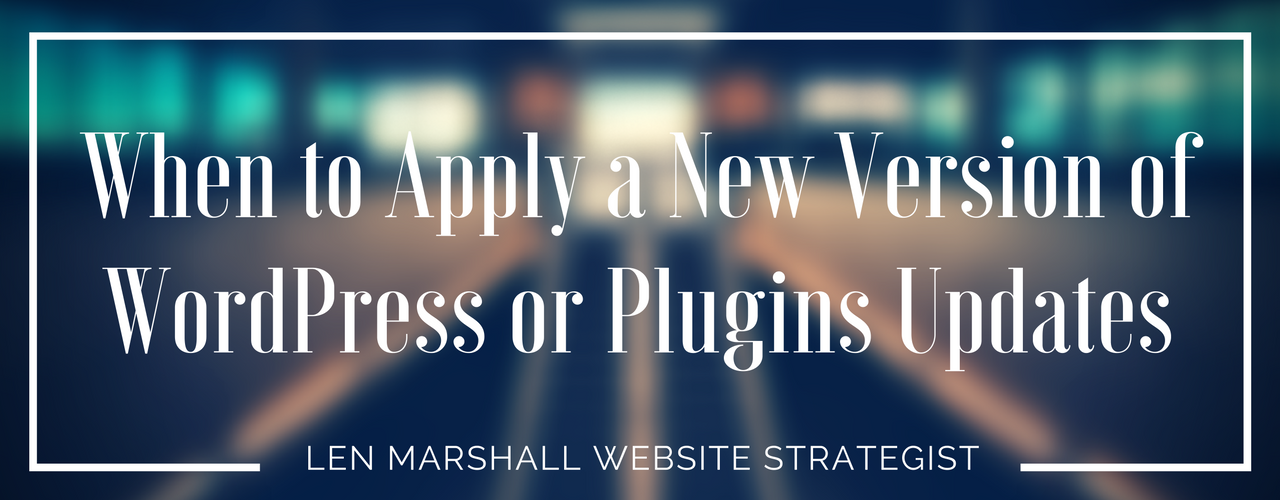
One of the first questions all of my clients ask when I present them with the keys to the car (ie: give them access to their new WordPress website) is: How do I know when to apply updates such as a new version of WordPress or plugins and themes?
Naturally, it seems like a straight-forward question, and would likely have a simple answer.
So, here’s the simple answer:
When you log into your WordPress dashboard, you’ll see any available updates highlighted in a couple of places. You’ll see notifications for WordPress updates at the top of all the admin pages in the Dashboard. You’ll see the number of plugin updates in a little bubble next to “Plugins” on the left-side menu.
For a complete list of available updates, including themes, plugins and WordPress upgrades, go to Dashboard > Updates. WordPress makes updating software easy. It’s never harder than clicking a button or two. Yes, there are ways to update manually, but the one-click solution is typically all you need to use.
So, that’s how you know that there are updates available, but that doesn’t answer the deeper question of when to apply these updates.
[popup_trigger id=”5512″ tag=”span”]
Safely test updates on a temporary copy of your website.
Learn how with this step by step guide.
>>> Get The Free Guide < <<
[/popup_trigger]
But first, why should you keep your site updated?
There are five main reasons for keeping your WordPress website up to date:
- Security
- Performance
- Bug fixes
- Compatibility
- Features
Each of these is significant, but it can be argued that security is the most important of all.
WordPress is constantly being enhanced, and new features are added to the way the program runs, looks, and behaves. When a significant milestone in the development is reached, and the WP team are ready to release these features to the community of users, they push out an update. The update has a version number associated with it. Major updates (sometimes called Upgrades) are a full number change (like from v3.x to v4.x). Other minor updates for security patches, bug tweaks, or enhancements are usually a decimal number (like from v4.2 to v4.3)
When to Apply WordPress Updates
The development team is made up of hundreds of developers from around the world working to make the best software possible. They have a rigorous testing process before releasing updates. When your software powers more than 25% of the whole Internet, you don’t want to push out a half-baked update!
So, when that little notification about updating WordPress pops up, you should click the link and update the core software without hesitation.
I am always afraid that it will break something… Is there a way to test an update before I apply it?
WordPress software updates are safe to apply. But whether you’re doing your due diligence or just paranoid, and want to test the update on your own specific website, here’s two ways to do it:
- Back-up your entire website (database and all files). Apply the update. Test the site. Restore from the back-up if the update broke something, and try to figure out what caused the problem.
- Use a staging or development site as a guinea pig before applying the update to your real website.
You should be making back-ups of your website on a regular basis regardless of your update status, but let’s assume it hasn’t been done. Here are five good way to create your back-up, if you’re going to go the way of testing the update on your live website.
Testing Updates Safely on Staging Sites
A staging site is an exact copy of your website, often on a part of your web host’s server that isn’t publicly available. Testing on a staging site is great because you don’t need to worry about things going wrong on your live website. The staging site is a safe place to develop and test things, but you must be sure that you’re applying the same updates as would be on the live site.
There are a few different ways to create your own staging site and many premium hosting companies also offer the ability to create staging sites within your control panel. Doing it yourself is not hard but requires following some specific and careful steps and processes.
[popup_trigger id=”5512″ tag=”span”]
Follow these simple instructions to make your own staging site for FREE!
>>> Click Here < <<
[/popup_trigger]
If the updates all work out on the staging site, you know you can safely apply the same updates on your live website. But when things break down, the staging site can be used to troubleshoot the problem. Once you’ve found the issue, make sure you patch the same problems on your live website before applying the updates.
Wrapping it up
WordPress updates are important for keeping your website secure, fast and working smoothly. Don’t forget to apply them for any length of time. If you are worried that an update is going to break your website, back it up first or test on a separate copy of your website in a staging environment. You’ll find that the updates are reliable and you can apply them with confidence.
If you’re just too scared to apply updates, get me to manage them for you. Each of my Client Confidence Plans includes daily back-up and restore points, updating the WordPress software, testing and tweaking your website for compatibility.
